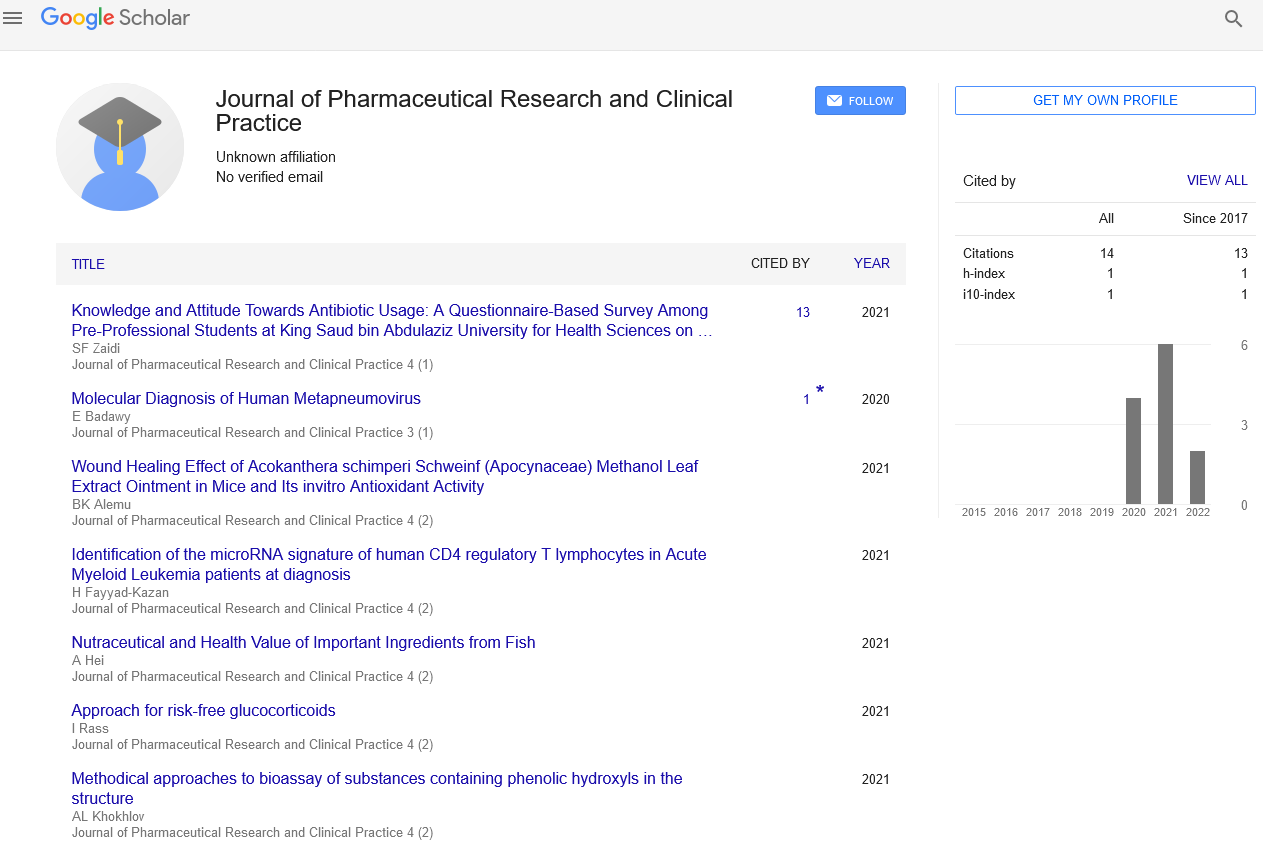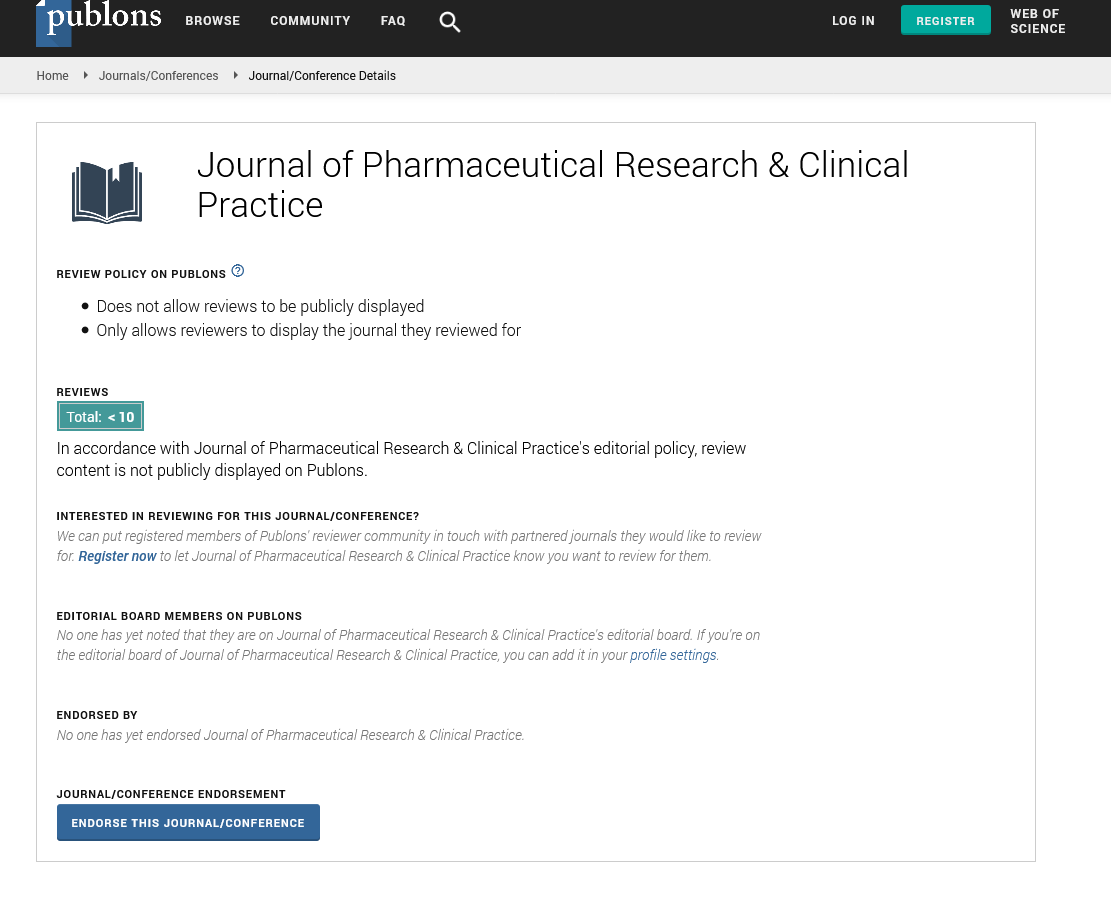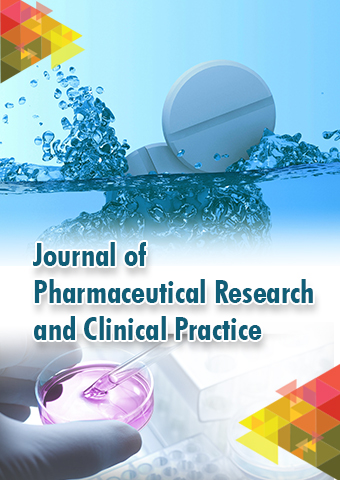Short Communication - Journal of Pharmaceutical Research and Clinical Practice (2023) Volume 6, Issue 3
Understanding Bioavailability: Maximizing the Potential of Medications and Nutrients
Jim Dylan*
Department of Clinical Practice, Switzerland
Department of Clinical Practice, Switzerland
E-mail: dyln_jim@gmail.com
Received: 02-June-2023, Manuscript No. jprcp-23-103124; Editor assigned: 05-Jun-2023, PreQC No. jprcp-23- 103124(PQ); Reviewed: 19-Jun- 2023, QC No. jprcp-23-103124; Revised: 23-Jun-2023, Manuscript No. jprcp-23-103124 (R); Published: 30-Jun-2023; DOI: 10.37532/ jprcp.2023.6(3).58-61
Abstract
Bioavailability, the degree and rate at which a substance is absorbed into the bloodstream and becomes available to its target site of action, is a critical factor in the effectiveness of medications and the utilization of nutrients. This article provides an overview of bioavailability, exploring the factors that influence it, including the route of administration, chemical characteristics of the substance, and individual variations in metabolism. The route of administration plays a significant role, with different methods presenting advantages and limitations in terms of speed and efficiency of absorption. Chemical properties such as solubility, stability, and interactions with binding proteins or enzymes also impact bioavailability. Individual variations, including genetics, age, health status, and concurrent medications, further contribute to variances in bioavailability. Strategies to optimize bioavailability, such as formulation optimization, innovative drug delivery systems, and considering individualized treatments, are discussed. Understanding and maximizing bioavailability are crucial for achieving desired therapeutic outcomes and ensuring the nutritional value of substances.
Keywords
Medications • Nutrients • Absorption • Pharmacokinetics • Pharmacodynamics
Introduction
In the realms of medicine and nutrition, the concept of bioavailability holds significant importance. Bioavailability refers to the extent and speed at which a substance, such as a medication or nutrient, is absorbed into the bloodstream and made accessible to its intended target within the body [1]. This factor plays a vital role in determining the effectiveness and efficiency of various treatments and dietary interventions. The concept of bioavailability encompasses the understanding that the mere presence of a medication or nutrient in a formulation or diet does not guarantee its optimal utilization by the body. Rather, it is the ability of the substance to be absorbed, transported, and ultimately reach its site of action that determines its efficacy [2]. Factors such as the route of administration, chemical characteristics of the substance, and individual variations in metabolism collectively influence the bioavailability of a substance. The route of administration plays a significant role in determining the bioavailability of medications and nutrients. For instance, oral administration, which involves ingestion through the mouth, is the most common route for medications and dietary supplements [3]. However, substances taken orally must traverse the digestive system, encountering various barriers that can potentially reduce their bioavailability. Conversely, intravenous administration directly introduces substances into the bloodstream, bypassing the digestive system and offering near-complete bioavailability. Different routes of administration have their own advantages and limitations in terms of speed, convenience, and predictability of effects. The chemical characteristics of a substance also influence its bioavailability [4]. Molecular size, solubility, stability, and interactions with binding proteins or enzymes can all impact how effectively a substance is absorbed and utilized by the body [5]. Solubility in bodily fluids, particularly water or fat, is crucial for facilitating absorption and transportation across cell membranes. Additionally, the stability of a substance within the gastrointestinal tract can affect its bioavailability, as it may be degraded by enzymes or encounter variations in pH.
Furthermore, individual variations in metabolism contribute to differences in bioavailability among individuals [6]. Genetic factors, age, sex, overall health, and the presence of underlying conditions or medications can all influence the absorption, distribution, metabolism, and excretion (ADME) processes. Genetic variations in drug-metabolizing enzymes can impact the bioavailability of medications, while age-related changes in organ function can affect the body’s ability to process and eliminate substances [7]. Individual health conditions, particularly those affecting the gastrointestinal tract, can interfere with nutrient or medication absorption [8]. Understanding and optimizing bioavailability are critical in maximizing the potential of medications and nutrients. By employing strategies such as formulation optimization, innovative drug delivery systems, and individualized treatment approaches, healthcare professionals can enhance bioavailability and ensure that substances reach their target sites in a timely and efficient manner [9]. This article aims to provide a comprehensive understanding of bioavailability and its significance in the context of maximizing the potential of medications and nutrients. By exploring the factors influencing bioavailability and discussing strategies for its optimization, we can unlock the full therapeutic and nutritional benefits of various substances, ultimately leading to improved health outcomes [10].
Material and Methods
Route of administration
The route through which a substance is administered can significantly impact its bioavailability. Common routes include oral (through the mouth), intravenous (directly into the bloodstream), intramuscular (into the muscle), transdermal (through the skin), and inhalation (via the respiratory system). Each route has its advantages and limitations in terms of how quickly and efficiently a substance can reach its target. Oral administration is the most common route for medications and supplements, but it also presents challenges. Upon ingestion, the substance must pass through the digestive system, where it may encounter enzymatic degradation and other barriers that can reduce its bioavailability. However, this route offers convenience and is generally safe and non-invasive. On the other hand, intravenous administration bypasses the digestive system, delivering the substance directly into the bloodstream. As a result, bioavailability is nearly 100%, and the effects are rapid and predictable. This method is commonly used for critical and time-sensitive situations but may carry certain risks and require medical expertise.
Chemical characteristics
The chemical properties of a substance greatly influence its bioavailability. Factors such as molecular size, solubility, stability, and the presence of binding proteins or enzymes can all affect how effectively a substance is absorbed and utilized by the body. For instance, a medication or nutrient must be soluble in the body’s fluids to be easily absorbed. Lipophilic (fat-soluble) substances have an advantage in crossing cell membranes, while hydrophilic (water-soluble) substances may require specific transport mechanisms. The stability of a substance within the gastrointestinal tract can also affect its bioavailability, as it may be degraded by enzymes or pH variations.
Individual variations
Each person’s physiology and metabolism can influence the bioavailability of a substance. Genetic factors, age, sex, overall health, and the presence of underlying conditions or medications can all contribute to individual variations in absorption, distribution, metabolism, and excretion (ADME) processes. For example, certain genetic variations can affect the function of drug-metabolizing enzymes, potentially altering the bioavailability of medications.Age-related changes, such as decreased liver or kidney function, can also impact how substances are processed and eliminated from the body. Additionally, certain medical conditions, such as gastrointestinal disorders, may interfere with the absorption of nutrients or medications.
Optimizing bioavailability: Maximizing the bioavailability of medications and nutrients is essential to ensure their effectiveness and therapeutic benefits. Several strategies can be employed to enhance bioavailability:
Formulation optimization: Developing drug formulations that enhance solubility, stability, and absorption can improve bioavailability. Techniques such as nanotechnology, prodrugs, and lipid-based delivery systems can be utilized to enhance the pharmacokinetic properties of substances.
Drug delivery systems: Innovative drug delivery systems, such as nanoemulsions, liposomes, and transdermal patches, can provide controlled release and targeted delivery, thereby improving bioavailability and reducing side effects.
Food interactions: Certain medications and nutrients may exhibit improved bioavailability when taken with or without specific foods. For example, some medications should be taken on an empty stomach to avoid interactions with food components that could affect absorption.
Individualized treatment: Considering individual factors, such as genetics, age, and health conditions, can help tailor treatments to maximize bioavailability. Personalized medicine and pharmacogenomics can provide valuable insights into how an individual may respond to specific substances. Bioavailability is a fundamental concept that impacts the effectiveness of medications and the nutritional value of the food we consume. By understanding the factors influencing bioavailability and employing strategies to optimize it, we can unlock the full potential of treatments and nutrients, ultimately leading to improved health outcomes.
Discussion
In the field of medicine and nutrition, one important concept that often arises is bioavailability. Bioavailability refers to the degree and rate at which a substance, such as a medication or nutrient, is absorbed into the bloodstream and becomes available to its target site of action in the body. It plays a crucial role in determining the effectiveness and efficiency of various treatments and dietary interventions. Bioavailability is influenced by several factors, including the route of administration, chemical characteristics of the substance, and individual variations in metabolism. Let’s delve deeper into these aspects to gain a better understanding of bioavailability and its significance.
Conclusion
Bioavailability is a crucial factor in maximizing the potential of medications and nutrients. Understanding the concept of bioavailability, including the factors that influence it, allows us to optimize the absorption and utilization of substances within the body. The route of administration plays a significant role in bioavailability, with different methods offering advantages and limitations. Oral administration is common but can encounter barriers in the digestive system, while intravenous administration bypasses these barriers for near-complete bioavailability. Choosing the appropriate route of administration can enhance the effectiveness of medications and nutrients. The chemical characteristics of a substance also impact its bioavailability. Solubility, stability, and interactions with binding proteins or enzymes influence absorption and utilization within the body. Considering these factors in formulation design can enhance bioavailability and therapeutic outcomes. Individual variations in metabolism further contribute to differences in bioavailability among individuals. Genetic factors, age, overall health, and coexisting conditions or medications can all influence how substances are processed and utilized. Taking into account individualized factors can help tailor treatments to maximize bioavailability and ensure optimal outcomes. Optimizing bioavailability requires a multi-faceted approach. Formulation optimization, such as utilizing innovative drug delivery systems, can enhance solubility, stability, and targeted delivery. Personalized medicine and pharmacogenomics provide valuable insights into individual responses to substances, aiding in treatment customization. By maximizing bioavailability, we can unlock the full potential of medications and nutrients, leading to improved therapeutic outcomes and nutritional benefits. The continuous exploration of bioavailability and its optimization strategies will contribute to advancements in medical and nutritional sciences, ultimately improving the overall health and well-being of individuals.
References
- Acharya UR, Faust O, Sree Vet al.Linear and nonlinear analysis of normal and CAD-affected heart rate signals.Comput Methods Programs Bio.113, 55–68 (2014).
- Kumar M, Pachori RB, Rajendra Acharya Uet al.An efficient automated technique for CAD diagnosis using flexible analytic wavelet transform and entropy features extracted from HRV signals.Expert Syst Appl.63, 165–172 (2016).
- Davari Dolatabadi A, Khadem SEZ, Asl BMet al.Automated diagnosis ofcoronary artery disease(CAD) patients using optimized SVM.Comput Methods Programs Bio.138, 117–126 (2017).
- Patidar S, Pachori RB, Rajendra Acharya Uet al.Automated diagnosis ofcoronary artery diseaseusing tunable-Q wavelet transform applied on heart rate signals.Knowl Based Syst.82, 1–10 (2015).
- Giri D, Acharya UR, Martis RJet al.Automated diagnosis ofcoronary artery diseaseaffected patients using LDA, PCA, ICA and discrete wavelet transform.Knowl Based Syst.37, 274–282 (2013).
- Maglaveras N, Stamkopoulos T, Diamantaras Ket al.ECG pattern recognition and classification using non-linear transformations and neural networks: a review. Int J Med Inform.52,191–208 (1998).
- Rajkumar R, Anandakumar K, Bharathi Aet al.Coronary artery disease (CAD) prediction and classification-a survey.Breast Cancer.90, 945-955 (2006).
- Goldberger AL, Amaral LA, Glass Let al.Physiobank, physiotoolkit, and physionet: components of a new research resource for complex physiologic signals.Circulation.101, 215–220 (2000).
- Lahsasna A, Ainon RN, Zainuddin Ret al.Design of a fuzzy-based decision support system forcoronary heart diseasediagnosis.J Med Syst.36, 3293–3306 (2012).
- Barnett, Clive.The consolation of neoliberalism.Geoforum.36, 7-12 (2005).
Indexed at, Google Scholar, Crossref
Indexed at, Google Scholar, Crossref
Indexed at, Google Scholar, Crossref
Indexed at, Google Scholar, Crossref
Indexed at, Google Scholar, Crossref
Indexed at, Google Scholar, Crossref


